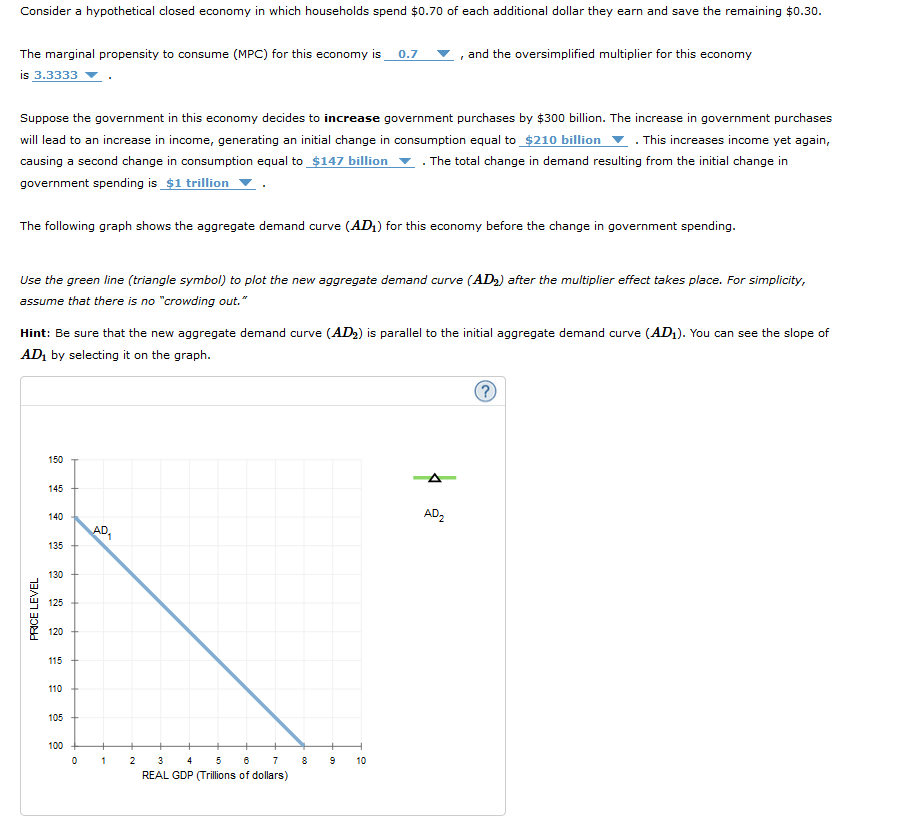Consider a hypothetical closed economy in which households spend $0.70 of each additional dollar they earn and save the remaining $0.30. The marginal propensity to consume (MPC) for this economy is 0.7 is 3.3333 and the oversimplified multiplier for this economy Suppose the government in this economy decides to increase government purchases by $300 billion. The increase in government purchases will lead to an increase in income, generating an initial change in consumption equal to $210 billion. This increases income yet again, causing a second change in consumption equal to $147 billion. The total change in demand resulting from the initial change in government spending is $1 trillion The following graph shows the aggregate demand curve (AD₁) for this economy before the change in government spending. Use the green line (triangle symbol) to plot the new aggregate demand curve (AD₂) after the multiplier effect takes place. For simplicity, assume that there is no "crowding out." Hint: Be sure that the new aggregate demand curve (AD₂) is parallel to the initial aggregate demand curve (AD₁). You can see the slope of AD, by selecting it on the graph
Consider a hypothetical closed economy in which households spend $0.70 of each additional dollar they earn and save the remaining $0.30. The marginal propensity to consume (MPC) for this economy is 0.7 is 3.3333 and the oversimplified multiplier for this economy Suppose the government in this economy decides to increase government purchases by $300 billion. The increase in government purchases will lead to an increase in income, generating an initial change in consumption equal to $210 billion. This increases income yet again, causing a second change in consumption equal to $147 billion. The total change in demand resulting from the initial change in government spending is $1 trillion The following graph shows the aggregate demand curve (AD₁) for this economy before the change in government spending. Use the green line (triangle symbol) to plot the new aggregate demand curve (AD₂) after the multiplier effect takes place. For simplicity, assume that there is no "crowding out." Hint: Be sure that the new aggregate demand curve (AD₂) is parallel to the initial aggregate demand curve (AD₁). You can see the slope of AD, by selecting it on the graph
Chapter21: Fiscal Policy
Section: Chapter Questions
Problem 20SQ
Related questions
Question
Consider a hypothetical closed economy in which households spend $0.70 of each additional dollar they earn and save the remaining $0.30.
The marginal propensity to consume (MPC) for this economy is0.7 , and the oversimplified multiplier for this economy is3.3333 .
Suppose the government in this economy decides to increase government purchases by $300 billion. The increase in government purchases will lead to an increase in income, generating an initial change in consumption equal to$210 billion . This increases income yet again, causing a second change in consumption equal to$147 billion . The total change in demand resulting from the initial change in government spending is$1 trillion .
The following graph shows the aggregate demand curve (AD1
) for this economy before the change in government spending.
Use the green line (triangle symbol) to plot the new aggregate demand curve (AD2
) after the multiplier effect takes place. For simplicity, assume that there is no “crowding out.”
I need help with the graphing part
Hint: Be sure that the new aggregate demand curve (AD2
) is parallel to the initial aggregate demand curve (AD1). You can see the slope of AD1 by selecting it on the graph.
Transcribed Image Text:Consider a hypothetical closed economy in which households spend $0.70 of each additional dollar they earn and save the remaining $0.30.
The marginal propensity to consume (MPC) for this economy is_ 0.7
and the oversimplified multiplier for this economy
is 3.3333
Suppose the government in this economy decides to increase government purchases by $300 billion. The increase in government purchases
. This increases income yet again,
will lead to an increase in income, generating an initial change in consumption equal to $210 billion
causing a second change in consumption equal to $147 billion v . The total change in demand resulting from the initial change in
government spending is $1 trillion
The following graph shows the aggregate demand curve (AD1) for this economy before the change in government spending.
Use the green line (triangle symbol) to plot the new aggregate demand curve (AD2) after the multiplier effect takes place. For simplicity,
assume that there is no "crowding out."
Hint: Be sure that the new aggregate demand curve (AD2) is parallel to the initial aggregate demand curve (AD1). You can see the slope of
AD, by selecting it on the graph.
150
A
145
140
AD2
135
130
125
120
115
110
105
100
2
4
7
10
REAL GDP (Trillions of dollars)
PRICE LEVEL
Expert Solution
This question has been solved!
Explore an expertly crafted, step-by-step solution for a thorough understanding of key concepts.
This is a popular solution!
Trending now
This is a popular solution!
Step by step
Solved in 2 steps with 1 images

Knowledge Booster
Learn more about
Need a deep-dive on the concept behind this application? Look no further. Learn more about this topic, economics and related others by exploring similar questions and additional content below.Recommended textbooks for you







Survey of Economics (MindTap Course List)
Economics
ISBN:
9781305260948
Author:
Irvin B. Tucker
Publisher:
Cengage Learning

